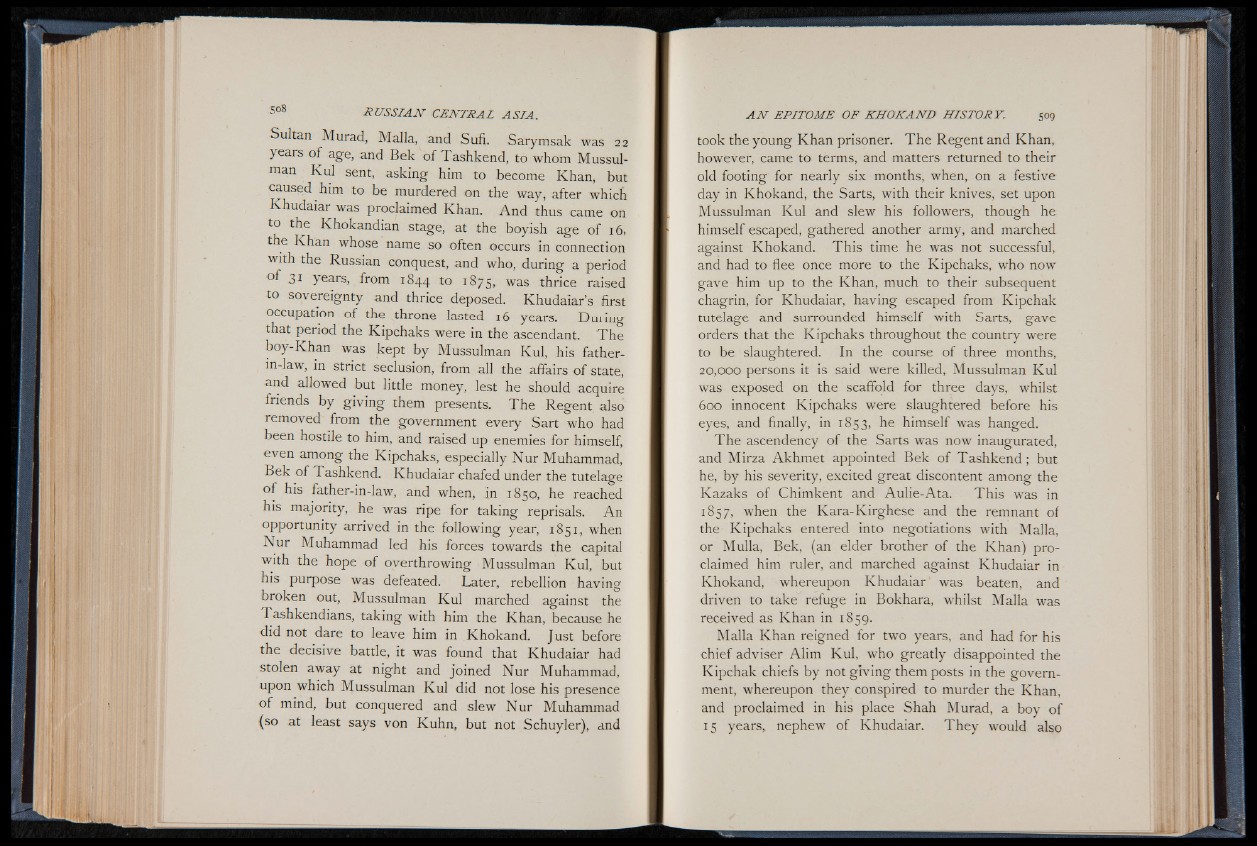
Sultan Murad, Malla, and Sufi. Sarymsak was 22
years of age, and Bek of Tashkend, to whom Mussulman
Kul sent, asking him to become Khan, but
caused him to be murdered on the way, after which
Khudaiar was proclaimed Khan. And thus came on
to the Khokandian stage, at the boyish age of 16,
the Khan whose name so often occurs in connection
with the Russian conquest, and who, during a period
of 31 years, from 1844 to 1875, was thrice raised
to sovereignty and thrice deposed. Khudaiar’s first
occupation of the throne lasted 16 years. During
that period the Kipchaks were in the ascendant. The
boy-Khan was kept by Mussulman Kul, his father-
in-law, in strict seclusion, from all the affairs of state,
and allowed but little money, lest he should acquire
friends by giving them presents. The Regent, also
removed from the government every Sart who had
been hostile to him, and raised up enemies for himself,
even among the Kipchaks, especially Nur Muhammad,
Bek of Tashkend. Khudaiar chafed under the tutelage
of his father-in-law, and when, in 1850, he reached
his majority, he was ripe for taking reprisals. An
opportunity arrived in the following year, 1851, when
Nur Muhammad led his forces towards the capital
with the hope of overthrowing Mussulman Kul, but
his purpose was defeated. Later, rebellion having
broken out, Mussulman Kul marched against the
Tashkendians, taking with him the Khan, because he
did not dare to leave him in Khokand. Just before
the decisive battle, it was found that Khudaiar had
stolen away at night and joined Nur Muhammad,
upon which Mussulman Kul did not lose his presence
o f mind, but conquered and slew Nur Muhammad
(so at least says von Kuhn, but not Schuyler), and
took the young Khan prisoner. The Regent and Khan,
however, came to terms, and matters returned to their
old footing for nearly six months, when, on a festive
day in Khokand, the Sarts, with their knives, set upon
Mussulman Kul and slew his followers, though he
himself escaped, gathered another army, and marched
against Khokand. This time he was not successful,
and had to flee once more to the Kipchaks, who now
gave him up to the Khan, much to their subsequent
chagrin, for Khudaiar, having escaped from Kipchak
tutelage and surrounded himself with Sarts, gave
orders that the Kipchaks throughout the country were
to be slaughtered. In the course of three months,
20,000 persons it is said were killed, Mussulman Kul
was exposed on the scaffold for three days, whilst
600 innocent Kipchaks were slaughtered before his
eyes, and finally, in 1853, he himself was hanged.
The ascendency of the Sarts was now inaugurated,
and Mirza Akhmet appointed Bek of Tashkend; but
he, by his severity, excited great discontent among the
Kazaks of Chimkent and Aulie-Ata. This was in
1857, when the Kara-Kirghese and the remnant of
the Kipchaks entered into negotiations with Malla,
or Mulla, Bek, (an elder brother of the Khan) proclaimed
him ruler, and marched against Khudaiar in
Khokand, whereupon Khudaiar was beaten, and
driven to take refuge in Bokhara, whilst Malla was
received as Khan in 1859.
Malla Khan reigned for two years, and had for his
chief adviser Alim Kul, who greatly disappointed the
Kipchak chiefs by not giving them posts in the government,
whereupon they conspired to murder the Khan,
and proclaimed in his place Shah Murad, a boy of
15 years, nephew of Khudaiar. They would also